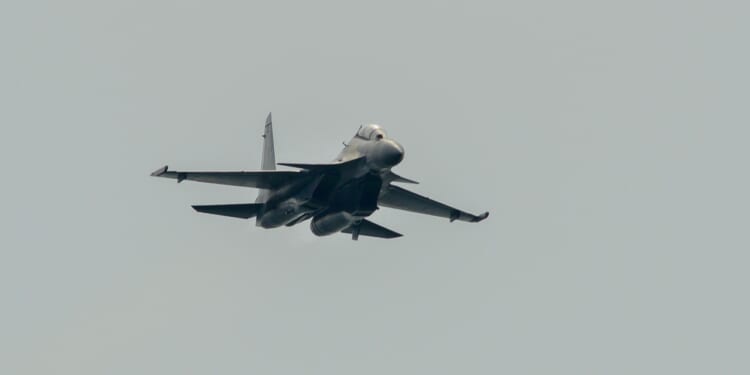Lithuania has claimed that two Russian aircraft entered its airspace without permission on Thursday—the third such accusation against Russia in the past month.
NATO member Lithuania condemned a violation of its airspace on Thursday, alleging that Russian aircraft briefly flew over its territory. Lithuanian President Gitanas Nausėda has instructed the country’s Foreign Ministry to summon the Russian Embassy’s representatives and issue a formal protest.
“This is a blatant breach of international law and the territorial integrity of Lithuania,” Nausėda wrote on X. “Once again, it confirms the importance of strengthening European air defense readiness.”
What We Know About Russia’s (Alleged) Airspace Violation
According to Lithuanian claims, at roughly 6pm local time on Thursday evening, two Russian aircraft—a Sukhoi Su-30 (NATO reporting name “Flanker-C/G/H”) multirole fighter and an Illyushin Il-78 (NATO reporting name “Midas”) four-engine aerial refueling tanker—entered Lithuanian airspace, flying about 765 yards (700 meters) into the Baltic nation before turning back. The violation is said to have lasted 18 seconds in total.
“This incident once again shows that Russia is behaving like a terrorist state, disregarding international law and the security of neighboring countries,” Lithuanian Prime Minister Inga Ruginienė wrote on Facebook.
The Russian Aerospace Force’s aircraft were believed to be conducting a refueling exercise in the Russian exclave of Kaliningrad when the breach of Lithuanian airspace occurred. Two Spanish Eurofighter Typhoon jet fighters, deployed to the region as part of NATO’s Baltic Air Policing (BAP) mission, were immediately sortied and flew to the border.
“This is another demonstration of NATO’s readiness to respond to any developments and ability to ensure the safety of the Alliance’s airspace,” a NATO official said in a statement, per Fox News.
Russia Regularly Antagonizes Eastern NATO Nations
Last month, Estonia, another Baltic NATO member and former constituent republic within the Soviet Union, accused Russian jets of violating its airspace. Three Russian Sukhoi Su-31 (NATO reporting name “Foxhound”) fighters operated off the coast of Estonia in the Gulf of Finland for nearly 12 minutes, close to the capital city of Tallinn.
Days after the Estonia incident, more than 20 Russian drones were reported to have crossed into Polish airspace, with NATO aircraft firing on the unmanned aircraft, marking the first time NATO had fired on Russian targets since the start of the war in Ukraine in February 2022.
After the most recent incident, the Russian Ministry of Defense issued a statement denying Lithuania’s claims of a border violation. It acknowledged that a training operation involving a Su-30 fighter jet and an Il-78 aerial tanker had taken place over the westernmost part of Kaliningrad, but insisted that they had remained within Russian airspace at all times.
“On October 23, Russia’s Su-30 fighter jets conducted scheduled training flights over the Kaliningrad Region. The flights were performed over Russian territory in strict compliance with international rules of the use of airspace. The aircraft neither deviated from the flight route nor violated other countries’ borders, as confirmed by objective control means,” the Russian Defense Ministry’s statement read, according to Russian news agency TASS.
Russia has recently increased its military activities in its exclave of Kaliningrad, which is roughly the size of Connecticut and wedged between NATO and EU members Poland and Lithuania. Kaliningrad has been described as an “unsinkable aircraft carrier” for the Russian Navy’s Baltic Fleet—and a persistent headache for NATO’s defense planners.
The History of Russia’s Kaliningrad Exclave
Kaliningrad is one of Russia’s 46 oblasts (administrative regions) and is the only one without a land border with another part of the country. The roots of the territory reach deep into history. For centuries, the city was known as Königsberg, and was one of the major cities of East Prussia, the predecessor state to modern Germany.
The Königsberg region was founded by the Teutonic Knights in 1255, and it has long been associated with German militarism. The city of Königsberg and the area around it, which at the time comprised about one-third of East Prussia, was occupied by the Soviet Red Army. In 1946, Soviet leader Joseph Stalin renamed it Kaliningrad in honor of the late Bolshevik leader Mikhail Kalinin, who had been chairman of the Presidium of the Supreme Soviet, the head of state of the Soviet Union.
The area once had a highly intermixed population that included Germans, Poles, Lithuanians, and Jews. Stalin ethnically cleansed most of the German population, and the Kremlin instituted a decades-long policy of “Russification” that sought to erase all traces of the city’s German heritage.
About the Author: Peter Suciu
Peter Suciu has contributed over 3,200 published pieces to more than four dozen magazines and websites over a 30-year career in journalism. He regularly writes about military hardware, firearms history, cybersecurity, politics, and international affairs. Peter is also a contributing writer for Forbes and Clearance Jobs. He is based in Michigan. You can follow him on Twitter: @PeterSuciu. You can email the author: [email protected].
Image: Shutterstock / Phuong D. Nguyen.

















